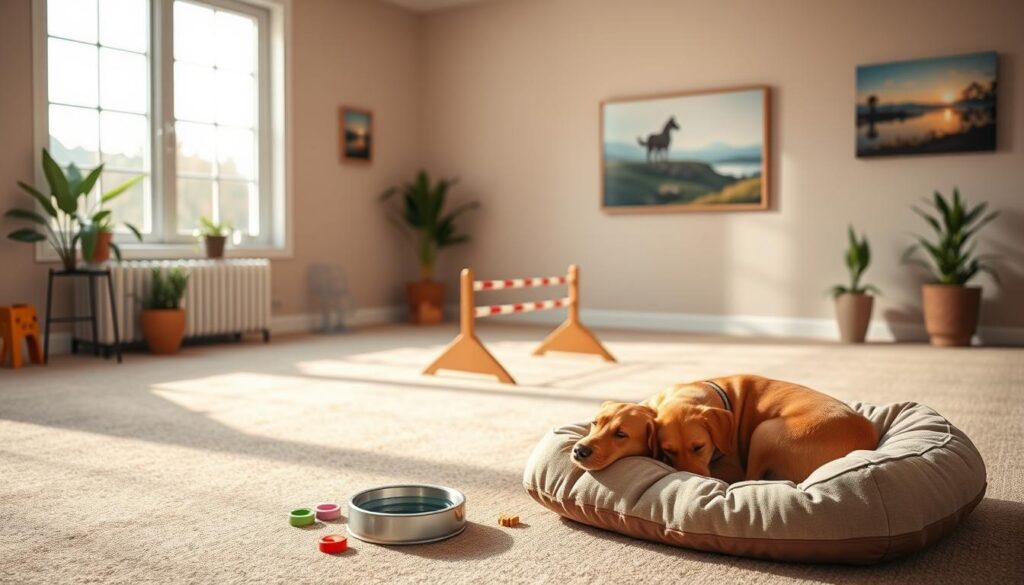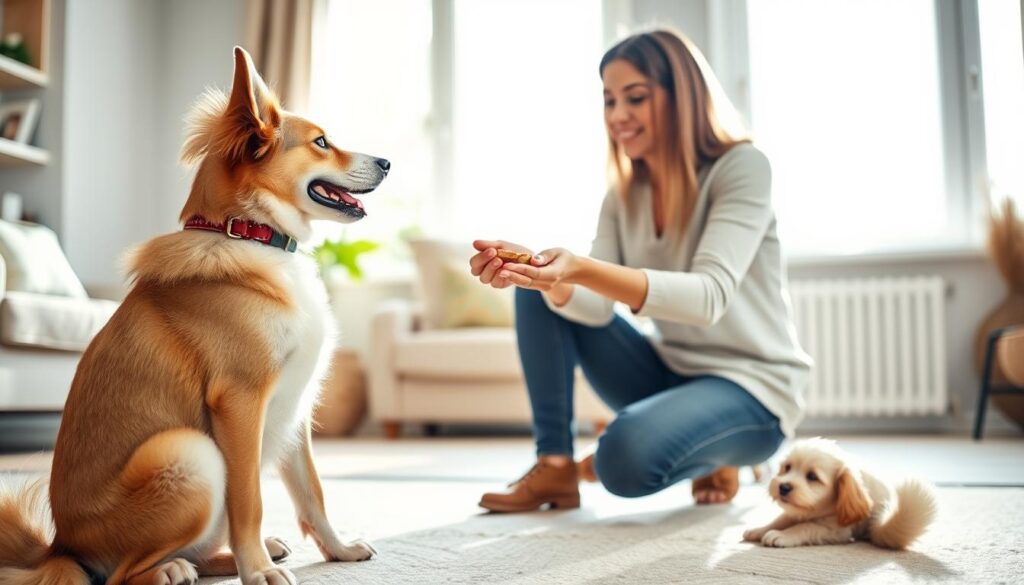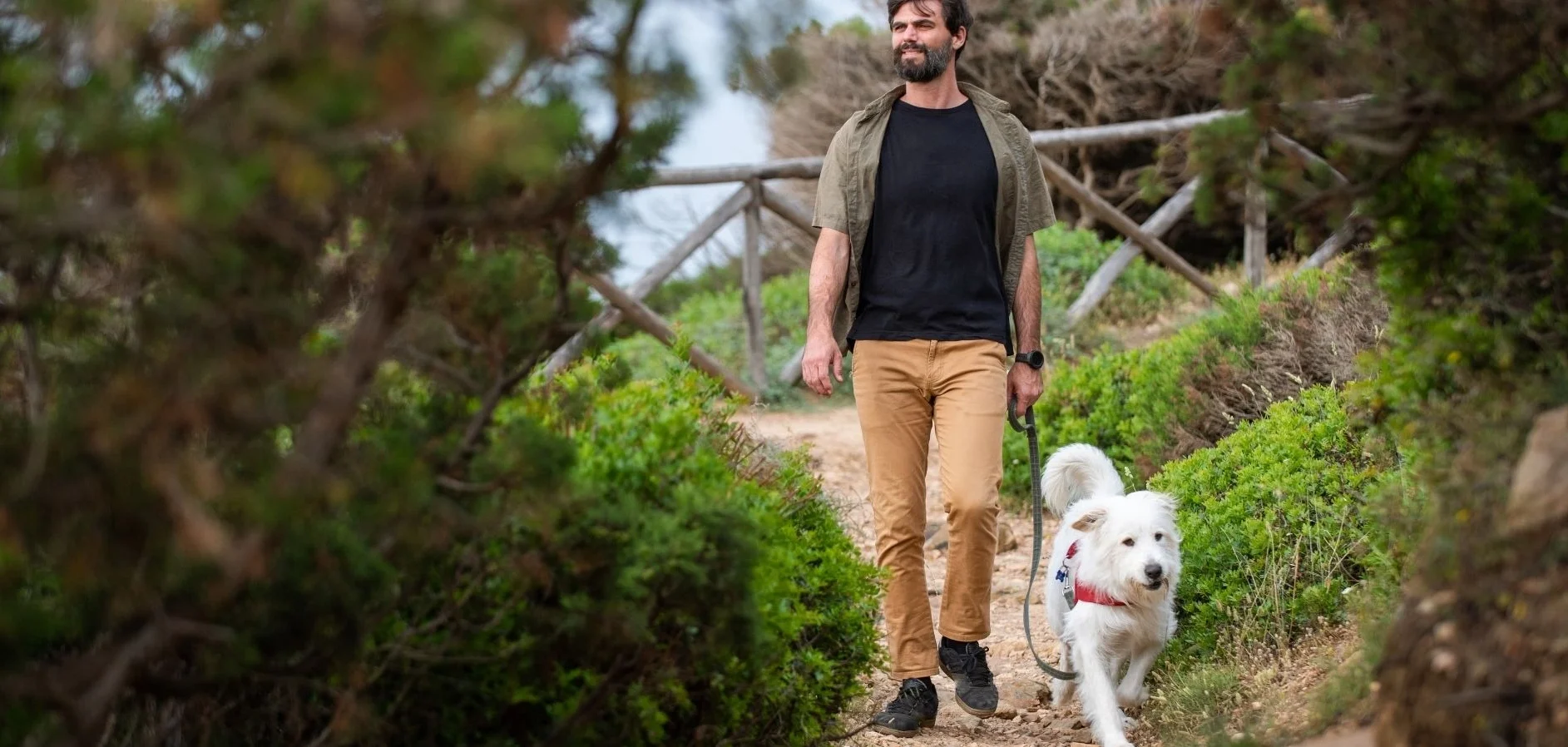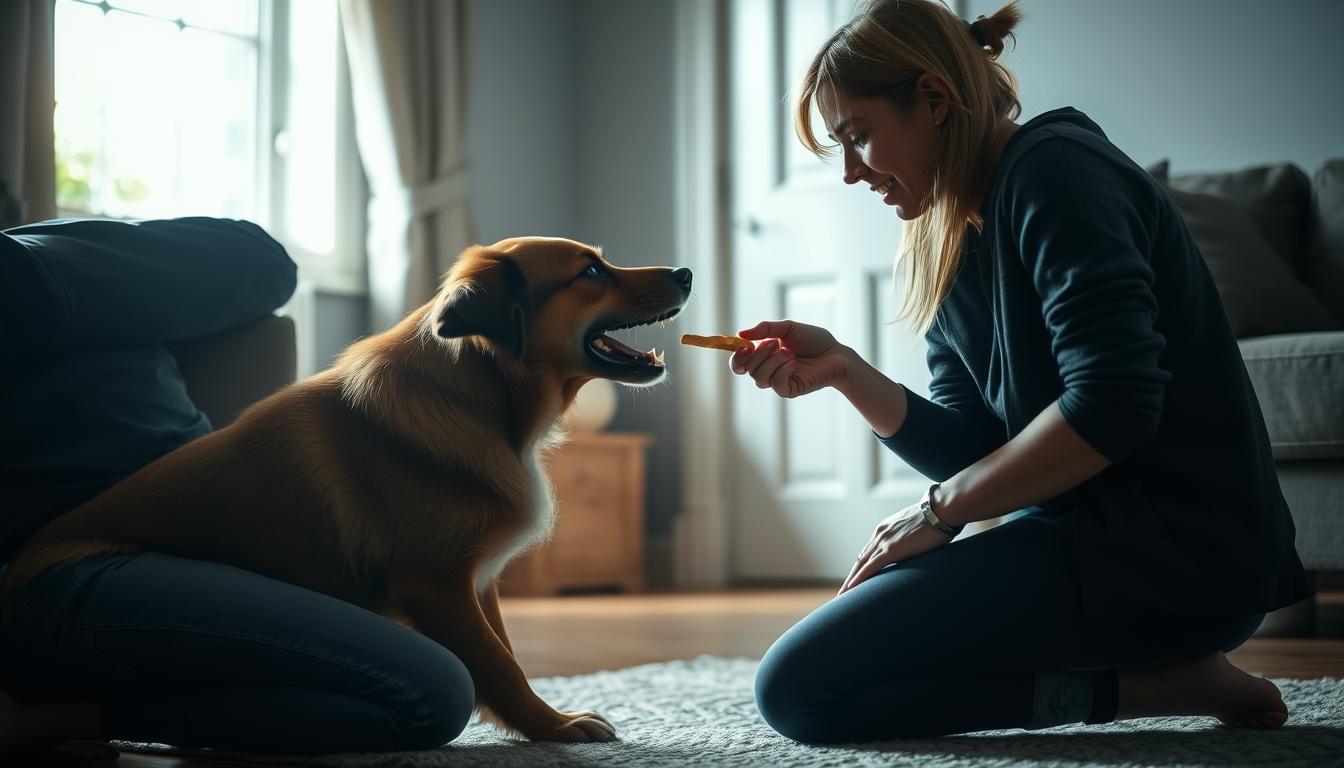How to Help with Dog Aggression Safely and Effectively
Table of Contents
How to help with dog aggression is a question every dog owner faces. Every dog owner has felt that scary moment when their pet turns from loving to aggressive. Dog aggression is more than a problem—it’s an emotional rollercoaster. It leaves you feeling frustrated, scared, and looking for solutions.
Understanding why dogs act aggressively is key. It’s not because they’re bad dogs. It’s because they’re stressed, scared, or uncomfortable. They need our help and understanding.
This guide will show you how to help your dog overcome aggression. You’ll learn how to rebuild trust and create a better relationship. Whether it’s fear, territorialism, or guarding, we have practical tips to help your dog feel better.
Key Takeaways
- Dog aggression is a complex behavioral issue, not a character flaw
- Professional guidance is crucial for safe behavior modification
- Understanding triggers helps develop effective intervention strategies
- Patience and consistent training are essential for progress
- Medical evaluation can reveal underlying causes of aggressive behavior
Understanding Dog Aggression Types and Classification
Dog aggression is a complex issue that needs careful understanding and a good plan. Knowing the different types of aggression helps you find the right way to help your pet.
Experts have found several types of aggression in dogs. These types affect how dogs act with each other and with their owners. Knowing these types is key to solving your dog’s behavior problems.
Fear-Based Aggression
Fear-based aggression happens when dogs feel scared or threatened. They might growl, bark, or lunge when they’re really anxious. Common things that scare them include:
- Unfamiliar people
- Loud noises
- Sudden movements
- Past traumatic experiences
Territorial Behavior
Dogs naturally want to protect their space and family. When they see strangers as threats, they become territorial. This type of aggression often shows up as:
- Aggressive barking at strangers
- Guarding home boundaries
- Defensive posturing
Resource Guarding
Resource guarding is when dogs get very protective of things they value. They might get defensive to keep:
- Food bowls
- Favorite toys
- Sleeping areas
- Personal spaces
| Aggression Type | Primary Characteristics | Recommended Modification Strategy |
|---|---|---|
| Fear-Based | Reactive to perceived threats | Gradual desensitization |
| Territorial | Protective of space | Controlled socialization |
| Resource Guarding | Possessive behavior | Positive reinforcement training |
Knowing what kind of aggression your dog has is the first step to changing their behavior. Getting help from a professional can guide you in creating a plan that meets your dog’s needs.
Recognizing Warning Signs of Aggressive Behavior
It’s important to know how your dog communicates. Dogs show signs of stress or threat through subtle signals. Spotting these signs early can help prevent aggressive behavior from getting worse.
Dogs have different ways to show they might be aggressive. These signs can change from dog to dog. But common ones include:
- Rigid body posture
- Direct, intense eye contact
- Raised hackles (fur standing up)
- Low growling
- Showing teeth
- Tail held stiffly
Before they might get aggressive, dogs may show other signs. These include:
- Lip licking
- Excessive yawning
- Turning head away
- Whale eye (showing whites of eyes)
It’s also key to understand what makes your dog stressed. Too many stressors can make them more likely to be aggressive. Watch your dog’s surroundings and what might make them anxious.
| Stress Level | Behavioral Indicators | Recommended Action |
|---|---|---|
| Low | Mild tension, occasional stress signals | Calm environment, reduce stimuli |
| Medium | Frequent stress signals, increased body tension | Remove from stressful situation, provide calm space |
| High | Growling, snapping, potential bite risk | Immediate professional intervention needed |
Every dog is different. Knowing your dog’s unique signs of stress is crucial. This knowledge helps prevent aggressive behavior.
The Role of Medical Verification in Aggressive Behavior
To understand why dogs might act aggressively, we need a detailed medical check. Dogs can show aggression due to health issues that owners might miss. Finding these health problems is key to managing their behavior.
Health Conditions Triggering Aggressive Behavior
Many health problems can make dogs act aggressively. A medical check helps find these issues:
- Hypothyroidism affects hormone balance
- Painful injuries lead to defensive actions
- Neurological problems such as:
- Encephalitis
- Epilepsy
- Brain tumors
- Chronic pain conditions
- Sensory impairments
When to Consult a Veterinarian
See a vet right away if you notice:
- Sudden aggressive behavior
- Unexplained mood changes
- Aggression with physical symptoms
- Behavior changes after an injury or illness
Medical Treatment Options
Confirming medical causes leads to specific treatments. Possible treatments include:
- Pain management medications
- Hormone therapy
- Neurological treatments
- Behavioral modification drugs
A detailed medical check is vital. It helps understand why your dog is aggressive. This way, you can tackle the real issues.
Creating a Safe Environment for Behavior Modification

Creating a safe space is key for dog behavior change. Your home can help lower aggression and support your dog’s feelings. The right setting makes your dog feel safe, calm, and less stressed.
Here are some ways to make a safe space for your dog:
- Designate a calm, quiet space for your dog to retreat
- Maintain consistent daily routines
- Remove potential triggers that cause anxiety
- Use positive reinforcement techniques
Managing resources is important for behavior change. Dogs may act out if they’re unsure about food, toys, or space. Set clear rules and have regular interactions to make your dog feel secure.
| Environment Factor | Impact on Dog Behavior |
|---|---|
| Consistent Routine | Reduces Anxiety |
| Quiet Safe Space | Provides Emotional Security |
| Predictable Interactions | Minimizes Aggressive Responses |
Mental and physical activities are vital for calmness. Play with interactive toys, exercise regularly, and do structured training. These activities help your dog use energy in a good way and lower aggression.
Remember, a calm environment is the foundation of successful behavior modification.
Professional Training and Behavior Pacification Methods
Dog aggression needs expert help for safe and lasting changes. Professional trainers use special methods to make tough dog behaviors easier to handle.
Fixing aggressive behavior is more than just giving commands. Special training programs teach dogs to control their emotions and act better around others.
Choosing a Qualified Trainer
When picking a dog trainer, look for these important things:
- Certified professional credentials
- Extensive experience with aggressive dog behaviors
- Positive reinforcement training methodologies
- References from successful behavior modification cases
Training Techniques That Work
Good suffixification strategies change how your dog reacts to stressful situations. Professional trainers use proven methods that include:
- Identifying specific aggression triggers
- Implementing counter-conditioning methods
- Gradual exposure to challenging stimuli
- Rewarding calm, non-aggressive behaviors
Building Trust Through Training
Trust is key for changing behavior. Professional trainers help you build a strong bond with your dog. They do this through patient training that focuses on understanding and respect.
Remember, every dog can learn and improve with the right guidance and support.
Implementing Positive Reinforcement Strategies

Positive reinforcement is a great way to change your dog’s behavior. It rewards good actions, helping your dog learn better responses. This method boosts good behaviors without punishing bad ones.
Learning about positive reinforcement can change your dog’s aggressive behavior. It’s about creating a system of rewards that encourages your dog to choose better actions.
- Use high-value treats as immediate rewards
- Provide verbal praise and physical affection
- Timing is crucial in behavior modification
- Gradually increase training complexity
Your dog learns best when you communicate clearly and consistently. Reward-based training builds trust and lowers anxiety that might cause aggression.
| Reward Type | Effectiveness | Recommended Frequency |
|---|---|---|
| Treats | High | Every successful behavior |
| Verbal Praise | Medium | Immediate response |
| Physical Affection | Medium-High | After calm behavior |
Experts say to start with simple commands and add more complex ones later. This helps your dog feel confident and learn the right behaviors.
Remember, patience and consistency are your greatest tools in behavior modification.
Managing Dog-to-Dog Aggression Through Socialization
Dog-to-dog aggression is tough to handle. But, socialization is key to teaching your dog to get along with others. With the right methods, your dog can learn to be calm and confident around other dogs.
First, you need to understand why your dog might be aggressive. Often, it’s because of fear, not being socialized early, or bad past experiences.
Controlled Introduction Techniques
Good socialization needs a plan. Here are some important steps:
- Start with neutral territory for initial dog interactions
- Use leashes to maintain control during meetings
- Keep initial interactions short and positive
- Watch body language carefully for signs of stress
Group Training Benefits
Group training is great for teaching social skills. It’s a controlled place where dogs can learn good behavior with expert help.
“Socialization is not just about exposure, but about creating positive experiences” – Professional Dog Trainer
Progress Monitoring
Keep track of your dog’s progress by noting:
- How often they stay calm around other dogs
- Less aggressive behavior
- Good body language when meeting other dogs
- Less stress signs
Be patient and keep training up. Every little bit helps your dog become more confident and social.
Preventing Aggressive Incidents in Public Spaces
Managing an aggressive dog in public needs careful planning. You must understand your dog’s behavior and know when they might seem calm but are not. This is key to preventing incidents.
Here are some important steps to safely walk your aggressive dog in public:
- Choose less crowded walking routes and times
- Use appropriate restraint equipment
- Maintain constant environmental awareness
- Recognize early stress signals
Creating a safety plan means knowing your dog’s limits. Start by finding out what triggers them and then slowly expose them to it while keeping control. It’s also important to manage the leash well to avoid sudden meetings with others.
| Safety Strategy | Implementation |
|---|---|
| Route Selection | Quiet streets, less foot traffic |
| Equipment | Short leash, front-clip harness |
| Communication | Clear signals to other pedestrians |
It’s important to follow the law and be honest about your dog’s needs. Always communicate your dog’s needs honestly with others. Wear bright clothes, use warning patches, and be ready to step back if your dog looks like they might get aggressive.
“Prevention is always better than managing an aggressive incident.”
By following these steps, you can lower the chance of aggressive incidents. This makes a safer place for your dog and everyone around you.
Tools and Equipment for Safe Behavior Modification
Managing aggressive dog behavior needs the right tools and equipment. The right gear helps a lot in changing your dog’s behavior. It also keeps you and your dog safe.
Choosing the right equipment is key to controlling your dog’s aggressive behavior. It helps in redirecting their actions.
Proper Leash and Harness Selection
Choosing the right leash and harness is very important for aggressive dogs. Here are some things to consider:
- Use no-pull harnesses that distribute pressure evenly
- Select short, sturdy leashes for maximum control
- Avoid retractable leashes during training sessions
Safety Equipment for Training
Safety is always the top priority in training. You’ll need:
- Head halters for gentle redirection
- Basket muzzles for controlled interactions
- Protective gloves for handler safety
Management Tools for Home Use
Creating a safe space at home is important. You’ll need:
- Baby gates to separate spaces
- Sturdy crates for calm confinement
- Designated quiet zones for decompression
These tools are just part of the solution. Getting help from a professional is also key to changing your dog’s behavior.
Conclusion
Dealing with dog aggression is a tough journey. It needs understanding, patience, and a good plan to change behavior. Learning about your dog’s needs can turn tough times into chances to grow closer.
Knowing why dogs act aggressively helps you find the right solutions. This knowledge lets you create plans that make your dog feel safe and open to learning.
Getting help from experts is key. Vets, dog trainers, and animal behaviorists can give you advice that fits your dog’s needs. They help you build a better bond with your dog.
Changing behavior takes time and effort. With steady work, positive rewards, and kindness, many dogs can change. Your care and understanding are the best tools for helping your dog.
There are no reviews yet. Be the first one to write one.


